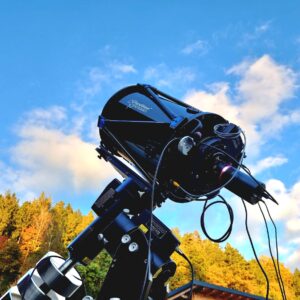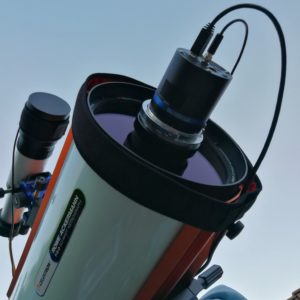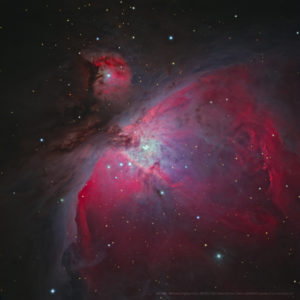Author Archives: Christoph Kaltseis
Christoph is not only an Adobe Photoshop specialist and as Nikon Professional touring for Nikon, but also an experienced astrophotographer. He is one of the founders of the Central European DeepSky Imaging Conference (www.cedic.at), which is held every two years in Linz since 2009.
In addition to his various projects, Christoph has developed an innovative image sharpening process called APF-R (Absolute Point of Focus)in recent years. The procedure is not always the same, but is adapted to the combination of lens and camera. Therefore, a flexible method was necessary to achieve the desired results.
In his career as an astrophotographer Christoph has also created several APODs (NASA Astronomy Picture of the Day), e.g. the APF-R-processed image of the M33 Galaxy or the Heart of the Orion Nebula (M42).
-
M31 in only 4,5 hours
This entry was posted on January 14, 2020 Last modified on February 27, 2024.
THE STORY: An M31 that fell from the sky The Andromeda galaxy is an object seen by every amateur astronomer, either with own eyes or as an image. I was particularly fascinated to image our magnificent neighboring galaxy with the RASA 8" - Rowe-Ackermann Schmidt Astrograph (#822252, € 2195,-) under a perfectly dark sky. This was one of the reasons why my way led me to La Palma for one week in October 2019, to do my images at the Athos Centro Astronómico (www.athos.org). The QHY 163M camera is a perfect fit on the RASA 8" in terms of field size and pixel scale for M31. For a monochrome camera, the Baader FCCT (Filter Changer Camera Tilter) for RASA 8" and QHY cameras (various versions available) (see...
-
First Light: PlaneWave DeltaRho 350 Astrograph
This entry was posted on November 11, 2022 Last modified on February 27, 2024.
I had the chance to test the DeltaRho 350 f/3 Astrograph (DR350) with the serial number 0003 – all in all this solution is absolutely remote capable! You can read my first impressions and experiences here: Setup and installation The unit is very well made and in combination with PlaneWave's focuser and de-rotator, it is quite a massive unit and surprisingly heavy. The center of gravity is at the back of the telescope. The PWI4 (beta) software that operates the DR350 telescope installs quickly and works immediately with Maxim DL. If you have problems, take a look at the USB settings in PWI4, which is used to operate the fans, the heating of the secondary and primary mirrors, the focuser, and the rotator. The DR350...
-
The Baader FCCT with the QHY 268M on the RASA 8 - Step by Step to Perfect Collimation
This entry was posted on June 14, 2022 Last modified on February 27, 2024.
If a sensor diagonal of 22mm is ideal for a sharp image with the RASA 8, but if you have got "only" a camera with a diagonal of 28.5mm is available - is a good image possible at all? I tried this out and will describe here step by step my way to the finished image with the Baader Baader FCCT (Filter Changer Camera Tilter) for RASA 8" and QHY cameras (various versions available) an the QHY 268M ( QHY 268 M/C BSI Cooled Medium Size APS-C Cameras (various versions available) (various versions available) ) on the RASA 8, especially the adjustment of the overall system. I suggest that you read all this before you try it out yourself! For safety's sake, check every step...
-
RASA 8 - mit QHY Kameras und Baader FCCT
This entry was posted on February 9, 2022 Last modified on February 28, 2024.
Wir bedauern die Verzögerung der Verfügbarkeit des FCCT sehr. Wir hatten den FCCT vor allem für die QHY163 M/C Medium Size CMOS Kameras, gekühlt entwickelt. Unser Kunde Christoph Kaltseis hatte den Prototyp bereits in der ersten Phase der Entwicklung mit der QHY163M testen können (siehe seinen Bericht unten). Als wir fast fertig waren, kam eine Nachricht von QHY, Sony würde den 163er Chip einstellen. Daraufhin haben auch wir die FCCT-Produktion frustriert eingestellt. Mitte 2021 war jedoch die QHY163 auf einmal doch wieder verfügbar – und wir wollten unbedingt auch eine Lösung für die nächstgrößeren Kameragehäuse mit 90 mm Durchmesser konstruieren. Daraus sind nun zwei Versionen des FCCT entstanden, sodass der FCCT II auf die neuen Kameras QHY 294M / C Pro Medium Size Cooled CMOS...
-
With the Baader M68-Tilter to perfect alignment
This entry was posted on January 17, 2022 Last modified on February 20, 2024.
The Baader M68 is a system that fulfils many wishes in an elegant way and with high stability. All distances can be set precisely, and with the Baader M68-Tilter (#2458170 , € 255,-) an ingenious extension has been added to the system. But before talking about the tilter, let me tell you how I came to this system. When I was testing the prototype of the Baader FCCT (Filter Changer Camera Tilter) for RASA 8" and QHY cameras (various versions available) for the RASA 8, I wished that the connection and collimation possibilities for the C14 were just as sophisticated. I have acquired enough experience so that I can "read" the image of the C14 so well that I know whether I am really seeing...
-
APF-R : Absolute Point of Focus
This entry was posted on September 27, 2017 Last modified on February 28, 2024.
APF-R goes online as official plugin in Adobe Photoshop Christoph Kaltseis is a Photoshop expert and an experienced astrophotographer. In recent years, he has developed APF-R (Absolute Point of Focus), an innovative image sharpening process in Photoshop that has attracted considerable interest among experts. The Hubble Space Telescope team has been using his method for over 2 years. Adobe Photoshop has now introduced the easy-to-use APF-R Photoshop CC plugin for Christoph's complex process. The tool sharpens images using APF-R with just a few clicks, even without much prior knowledge. The plugin has already proven many times that it can meet even the high quality standards in astrophotography. Read a very interesting in-depth interview with Christoph Kaltseis on Picture Instruments about his experiences in astrophotography. Christoph...
-
Celestron CGX mount in combination with StarAid Revolution as guiding cam
This entry was posted on September 2, 2020 Last modified on February 16, 2024.
The CGX: A Versatile Mount For Everyone! Recently I was able to work with the Celestron CGX, the Baader Apo 95/560 Travel Companion, the Nikon D810A and the StarAid Revolution as guiding system for the first time. Once again the results proved how much you can get out of a good system if you take some time to tweak the settings a little bit instead of simply working with the factory settings of the software without taking a closer look at them. To get straight to the point: I'm really excited about what the CGX delivered last night! For polar alignment, I used the star Regulus and the integrated AllStar Polar Alignment (ASPA) system of the CGX. My alignment routine only consisted of a 2-star alignment, with...
-
SUW 08/20: In the Heart of M42 with a C14 EdgeHD
This entry was posted on July 8, 2020 Last modified on February 28, 2024.
THE STORY: In the Heart of M42 When we were still shooting on film, it was just like today: The Orion Nebula has always been on the most-wanted-list of practically every astrophotographer. This starts with wide field shots and ends with detailed images of the surroundings of the trapezoid stars in the heart of M42. This region of M42 is much brighter than the faint surroundings, and this enormous dynamic range makes photography especially tricky. The structures require a long focal length and a wide aperture to let them shine. For my imaging I chose Celestron's C14 EdgeHD, which is still compact despite its size and therefore doesn't require an gigantic mount. At an f/ratio of f/7.6 with the special reducer designed for full-frame cameras, I...
-
1st Light with the QHY600 EB: a first field report
This entry was posted on June 2, 2020 Last modified on February 26, 2024.
Darkness Became Light! ... A Quantum Leap in 36 x 24mm at 61.1MP? In recent years, color cameras have become increasingly popular. A reversal of the trend is not to be expected. One reason for this is the ability to capture weak structures in deep-sky objects even with moderate exposure times. Developments in CMOS sensors and recently the BSI sensor technology have played a decisive role in this. In addition, both quantum efficiency (QE) and full-well capacity increased, noise was reduced, pixels became smaller and smaller, and dynamics increased with almost every new sensor generation. What happens when all these developments see the light of the stars in a new camera like the QHY 600M with a black and white sensor? I had asked myself...
-
SUW 05/20 Poster: CDK 14 and Veil Nebula - it can be so easy
This entry was posted on April 15, 2020 Last modified on February 28, 2024.
THE STORY: Veil Nebula and Planewave CDK14 – it can be so easy The "Veil Nebula" NGC 6960 is a remnant of a supernova explosion that occurred 8000 to 10,000 years ago. With a length of over one degree it is huge - and the Cygnus loop, to which the Veil Nebula belongs, is even larger at around 2°! For this picture, images from two nights were combined, whereby subframes with seeing values worse than 2.05" FWHM were not used. Now, I have to admit my preference for long focal lengths right at the beginning. As far as conditions allow, I want to get details out of the pictures - and since I have a location that often has good to very good seeing, I...















